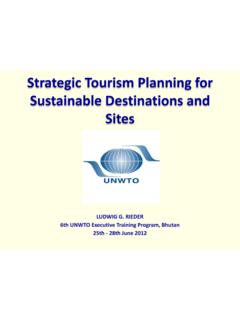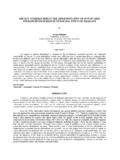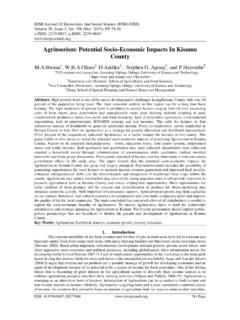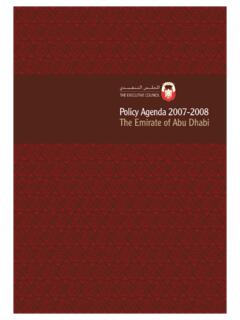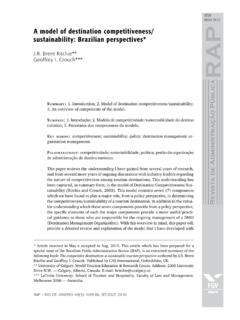Transcription of Route report EuroVelo Route 7 Middle Europe Route or The ...
1 Route report EuroVelo Route 7. Middle Europe Route or The Sun Route December 2004. Jens Erik Larsen De Frie Fugle Denmark Content 0. About the Route and EuroVelo 1. Norway and Finland General overview Route description Technical facts Further information - maps and guides Contacts 2. Sweden General overview Route description Technical facts Further information - maps and guides Contacts 3. Denmark General overview Route description Technical facts Further information - maps and guides Contacts 4. Germany General overview Route description Technical facts Further information - maps and guides Contacts 5. Czech Republic General overview Route description Technical facts Further information - maps and guides Contacts 6.
2 Austria General overview Route description Technical facts Further information - maps and guides Contacts 7. Italy General overview Route description Technical facts Further information - maps and guides Contacts 8. Malta General overview Route description Technical facts Further information - maps and guides Contacts Conclusion/overview 2. Colofon This Route report has been prepared with funding from: Danish Tourist Board - City of Copenhagen - Turisme region syd/ stdansk Turisme - De Frie Fugle Denmark - FIAB/Cyclists Federation of Italy - Frontpage Photo: Thanks to Sissel Jenseth Norway 3. 0. Background for EuroVelo Introduction to EuroVelo , the European cycle Route network EuroVelo is the project, initiated by the European Cyclists Federation in 1995, to develop 12 long- distance international cycle routes spanning all of Europe both within and beyond the EU.
3 It is being developed by organisations representing most countries in Europe , coordinated by the ECF, De Frie Fugle and Sustrans. EuroVelo is already happening. The proposed routes, totalling 63,500 km, are based largely on the cycle routes already existing or planned, at local, regional and national level, in the countries through which they pass. More than 21,000 km of the routes are already in place, but EuroVelo is not simply about creating routes - it is about linking them into a pan-European whole. This continental perspective has allowed the EuroVelo vision to support a number of Route creation projects since its launch. EuroVelo allows the EU to involve itself directly in promoting the use of the bicycle, which although primarily a local mode of transport is also ideally suited to gentle, sustainable tourism, both by itself and in conjunction with public transport.
4 It allows exchange of best practice between regions, and offers a European-level marketing vehicle for the bicycle as a modern and practical way of travelling. The guiding principle of EuroVelo is to develop a European network of cycle routes in order to promote a shift from the private car to the bicycle. Role of EuroVelo in the promotion of cycling The future for cycling has never been brighter. European and national policies, on global climate change, local air quality, road safety, tourism development among others, all suggest the possibility of promoting cycling. To do this, champions of cycling need need to act on various levels to change the public agenda.
5 In local communities, small changes and small-scale projects can assist the use of the bicycle both as a means of transport and for leisure. In bigger cities local cycle Route networks, traffic calming, cycle parking and other measures can encourage a greater level of cycle use. Both are delivered locally, and both can bring about a move away from the car. Linking these progressive communities will be the long distance cycle routes. These will encourage short recreational trips by local residents but will also form the framework for the development of national and international cycle tourism. It is at this level that the EuroVelo project can make a significant difference.
6 The possibility of a local Route becoming part of a pan-European sustainable transport network is a tempting prospect for the citizens, administrators and politicians of any community. High quality cycling facilities will show that the communities on the EuroVelo network are European leaders in this developing area of transport provision; they will be able to enhance their reputation and gain useful publicity both at home and internationally. Meanwhile, the EU can work towards its European-level objectives in modal shift away from the car, without compromising the principle of subsidiarity. 4. Yesterday trade - tomorrow's tourists Towns and cities once vied with each other to be on long distance commercial trade routes.
7 Trade now creates such environmental problems that it is unwelcome in many communities and has been banished to motorways, airports and rail. Towns are now often divorced from the industrial and commercial traffic that was their original reason for being. EuroVelo can bring a new breed of international traveller back to the local community; on bikes. Cycle tourism is already happening. In 1998, the first year of operation of the Swiss national cycle network, it generated tourist revenues of more than 70 million. A study for EuroVelo estimated that by 2020 cycle tourism could bring as much as billion per year to the European economy, much of it in rural communities and destinations.
8 Long distance cycle routes can bring a demand for food, services and accommodation to the small communities bypassed by car-borne tourists. History and achievements of EuroVelo The European Commission supported the initial feasibility studies on the EuroVelo network, to investigate whether the original vision of a group of ECF members was viable. During 1997/8 a multi- national team surveyed the EuroVelo routes in outline, assessed the political and social atmosphere within which the network must be developed, and commissioned an appraisal of the potential for European cycle tourism. This work was co-funded by more than 50 bodies, public and private, from 20 different countries.
9 EuroVelo has created a very strong brand image despite the limited resources available. This has supported the creation of many sections of Route in individual local projects. Examples include the 100km Destra Po in northern Italy, the Silesia routes network in Poland, EuroVelo Route 9 through the eastern Weinviertel in Austria, or the Baltic Sea Route being developed through eight countries. EuroVelo has also helped to harmonise standards across Europe , both by the production and distribution of the EuroVelo Guidelines for Implementation and by direct assistance, such as to Estonia and Slovenia in planning national cycle signage systems (based on the system used in Denmark and the UK).
10 More than 21,000 km of Route are now in place; one of the tasks for which resources are now needed is to survey more accurately the state of development of these routes. The EuroVelo partners believe that in the long term EuroVelo should be adopted as the first truly sustainable Trans-European Network. While the EuroVelo vision has won hearts across the continent and has shown itself robust enough to play an important part in supporting many cycle infrastructure projects, it would be unrealistic to expect continued development to the highest standards without a central body to coordinate and assure quality control. EuroVelo , as the only European-scale sustainable transport project, needs and deserves a central office and budget, and we continue to call for its establishment.
